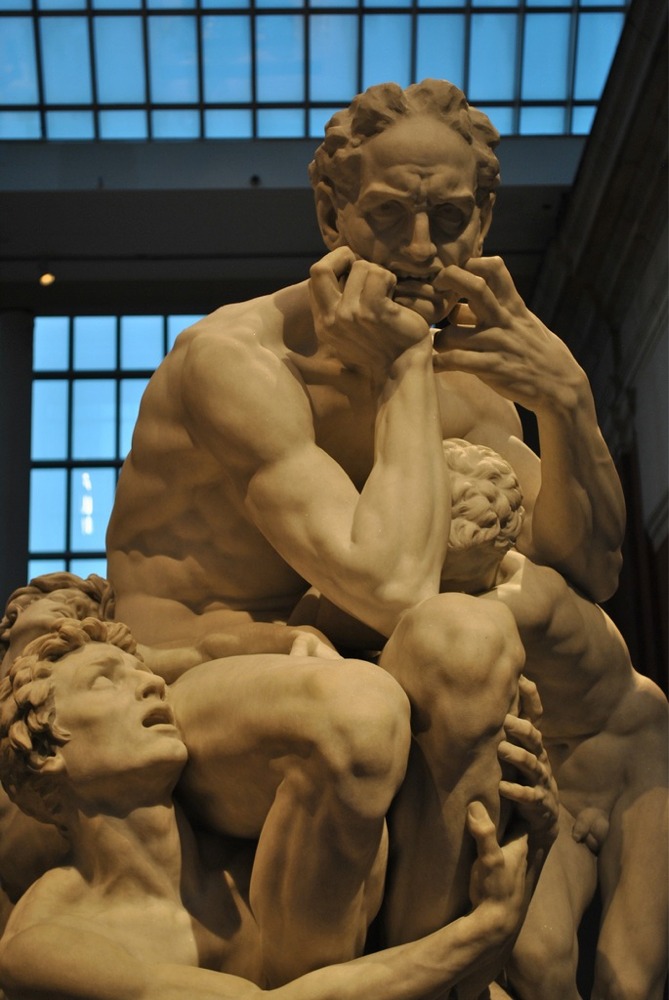Ugolino and His Sons
Home > New York State Photographs > Metropolitan Museum of Art > Ugolino and His Sons

This photograph shows a close-up view of Ugolino and His Sons in the Carroll and Milton Petrie European Sculpture Court at the Metropolitan Museum of Art in New York City.
Ugolino and His Sons
Ugolino and His Sons is a marble sculpture of Ugolino made by Jean-Baptiste Carpeaux in Paris during the 1860s. It depicts the story of Ugolino from Dante's Inferno in which the 13th-century count is imprisoned and starving with his children. The work, known for its expressive detail, launched Carpeaux's career.
Description and style
The work is a highly expressive depiction of Ugolino della Gherardesca from Canto XXXIII of Dante's Inferno. In the story, the Pisan count Ugolino is sentenced to die in a tower prison with his children and grandchildren. Carpeaux shows Ugolino at the moment when he considers cannibalism. The work is emblematic of the Romantic style's heightened physical and emotional states. Ugolino looks into the distance. His posture ignores the four children that cling to his body as if he were unaware they were there—the youngest is curled at his feet and possibly dead. In the source text, Ugolino grieves the agonizing death of his children and whether he eats his children's flesh is unclear to the reader, as it is in the sculpture. Ugolino's body is muscular even though he is starving. Its style reflects the Vatican's Laocoön and His Sons.
Production
Carpeaux won the Prix de Rome in 1854. While in Rome, he stayed in the French Academy in Rome's Villa Medici and studied the works of Michelangelo. Carpeaux's Ugolino was prototyped on Michelangelo's works from three centuries prior, particularly his Last Judgment panel of the Sistine Chapel. The children's anatomy was based on naturalistic observation. He sketched dying children as part of his preparation. He was compositionally influenced by Laocoön and His Sons at the Vatican. Carpeaux completed the work in the last year of his residence at the French Academy in Rome.
The sculpture was cast in bronze in 1863 by the French Ministry of Fine Arts and displayed in the Parisian Tuileries to accompany a replica of Laocoön. A marble version was completed in Paris under Carpeaux's supervision for the owner of the Saint-Béat marble quarry to exhibit at the 1867 International Exposition. This version was later acquired by the Metropolitan Museum of Art in New York City.
Reception
The initial release of the plaster model created a "public sensation". Ugolino and His Sons departed from the French Academy's tradition with "boldness and vigor" and the "spirit and masterly technique worthy of Michelangelo". The sculpture, and Carpeaux, were considered descendants of the 1830s French Romantic sculptor tradition associated with François Rude and Auguste Préault. Carpeaux admired the works of Rude, who once served as his mentor. Ugolino and His Sons launched Carpeaux's career and led to his commission for the façade of the Palais Garnier opera house: La Danse, a work that made him famous.
Legacy
Surrealist artist Max Ernst used a woodcut of Ugolino, presumably from the International Exposition's catalog, in his 1929 graphic novel La femme 100 têtes. His collage preserves the terror of Ugolino's face, but juxtaposes it against musical instruments.
European sculpture and decorative arts
The European Sculpture and Decorative Arts collection is one of the largest departments at the Met, holding in excess of 50,000 separate pieces from the 15th through the early 20th centuries. Although the collection is particularly concentrated in Renaissance sculpture—much of which can be seen in situ surrounded by contemporary furnishings and decoration—it also contains comprehensive holdings of furniture, jewelry, glass and ceramic pieces, tapestries, textiles, timepieces, and mathematical instruments. In addition to its outstanding collections of English and French furniture, visitors can enter dozens of completely furnished period rooms, transplanted in their entirety into the Met's galleries. The collection even includes an entire 16th-century patio from the Spanish castle of Vélez Blanco, reconstructed in a two-story gallery, and the intarsia studiolo from the ducal palace at Gubbio. Sculptural highlights of the sprawling department include Bernini's Bacchanal, a cast of Rodin's The Burghers of Calais, and several unique pieces by Houdon, including his Bust of Voltaire and his famous portrait of his daughter Sabine.
The Metropolitan Museum of Art of New York
The Metropolitan Museum of Art in New York City, colloquially "the Met", is the largest art museum in the Americas. Its permanent collection contains over two million works, divided among 17 curatorial departments. The main building at 1000 Fifth Avenue, along the Museum Mile on the eastern edge of Central Park on Manhattan's Upper East Side, is by area one of the world's largest art museums. A much smaller second location, The Cloisters at Fort Tryon Park in Upper Manhattan, contains an extensive collection of art, architecture, and artifacts from medieval Europe.
The Metropolitan Museum of Art was founded in 1870 with its mission to bring art and art education to the American people. The museum's permanent collection consists of works of art from classical antiquity and ancient Egypt, paintings, and sculptures from nearly all the European masters, and an extensive collection of American and modern art. The Met maintains extensive holdings of African, Asian, Oceanian, Byzantine, and Islamic art. The museum is home to encyclopedic collections of musical instruments, costumes, and accessories, as well as antique weapons and armor from around the world. Several notable interiors, ranging from 1st-century Rome through modern American design, are installed in its galleries.
The Fifth Avenue building opened on March 30, 1880. In 2021, despite the COVID-19 pandemic in New York City, the museum attracted 1,958,000 visitors, ranking fourth on the list of most-visited art museums in the world.
From Wikipedia, the free encyclopedia.


